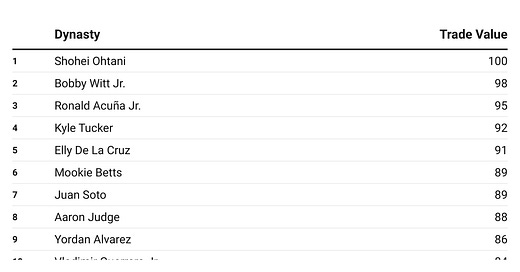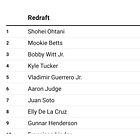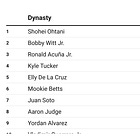Fantasy Baseball Dynasty Top 700 Rankings & Trade Value Version 2.07
An in-depth look at why it might be time to trade away Kevin Gausman. Plus more on Jace Jung and why now's the time to trade for him.
With first year player draft season upon us, there’s a chance you’ve already competed said draft for your league this year. Even if that hasn’t happened yet, there should be ample opportunity for trading.
Rebuilding teams looking to move the veterans they weren’t able to in the offseason, teams looking to take a step forward by adding a few additional players ahead of the regular season. Contenders trying to add a player or two who will put them over the top.
All of it applies.
Whichever category applies to you, it’s always the right time to make a trade. With that in mind, this week’s column provides a look at a Blue Jays veteran who you might consider trading away, that is if another team in your league still values him as a frontline fantasy starting pitcher.
Plus a look at a Tigers infielder on the rise and why now is the ideal time to trade for him.
And updated trade rankings!
If you have any questions about specific dynasty trade offers for your team or are curious about an offer you were thinking of sending out, becoming a paid subscriber grants you daily access to my fantasy help chat where I’ll be answering all of your fantasy baseball questions every weekday, whether it’s offseason, the regular season or the fantasy playoffs. The main goal of this Substack? To help you win your fantasy leagues.
Kevin Gausman (#138, 42 trade value).
Judging purely based on a smattering of surface-level stats, one might not be overly worried about Kevin Gausman’s production. He still won 14 games in 31 starts spanning 181 innings while logging a reasonably solid 3.83 ERA.
And while those stats were certainly fine from a fantasy standpoint – the 34-year-old also rattled off 16 quality starts and a pair of complete games – a look at his other metrics (both surface level and underlying) reveal a not so great story.
Consider first and foremost that the 34-year-old struck out 162 batters in 181 innings in 2024.
In 2023 he threw 185 innings. And struck out 237 batters.
That’s a seismic drop in strikeout rate, with the number dipping from 31.1% in 2023 to 21.4% last year. It ended a run of four straight years with a strikeout rate north of 28% for the right-hander. Elsewhere, he saw his swinging strike rate drop to 10.5%, well below his career 12.2% average. More notably, it was the lowest the veteran’s swinging strike rate has been since the 2014 season. Unfortunately, there are no typos in that last sentence.
His split finger offering generating fewer swings and misses – its whiff rate was 33.5% last year, down from 43.2% in 2023 – is certainly part of the equation here. The pitch hadn’t logged a whiff rate south of 40% since 2018.
However, there are two other notable pitch developments to consider as well.
One is Gausman’s slider. It routinely generated whiff rates in the 35-45% range. Last year, that number dropped to 26.6%, even with a lower usage range.
Kevin Gausman’s slider by season:
2024: 82.7 MPH, 26.6% whiff rate, 8.4% usage rate
2023: 86.3 MPH, 35.3% whiff rate, 10.2% usage rate
2022: 84.4 MPH, 36.8% whiff rate, 14.4% usage rate
2021: 82.0 MPH, 42.0% whiff rate, 6.2% usage rate
2020: 81.9 MPH, 29.2% whiff rate, 6.7% usage rate
However, and this probably isn’t too surprising considering the downward trend in swings and misses on Gausman’s splitter and slider, is that hitters were able to do more damage against his four-seamer.
Opposing batters turned in a .379 xwOBA and a .532 xSLG against the pitch, which also doubled as the highest xwOBA and xSLG against the pitch that Gausman has allowed since his career resurgence in 2020 with the San Francisco Giants.
(Opposing batters also logged a .278 xBA against the pitch).
In a perfect world, those numbers bounce back in 2025, but it might be time to consider, at the very least, trade offers on Gausman in dynasty leagues.
That’s not to say you should go out and trade him just to trade him.
But, if someone in your league still values the 34-year-old as a frontline fantasy starting pitcher, now might be the time to work out a deal, especially considering the veteran finished in the 36th percentile or lower in strikeout rate (21.4%, 36th percentile), whiff rate (23.4%, 33rd percentile), ground ball rate (39.3%, 32nd percentile), xBA (.257, 24th percentile), xERA (4.71, 19th percentile), hard-hit rate (42.4A%, 18th percentile) and barrel rate (9.7%, 14th percentile).
Jace Jung (#273, 32 trade value).
There’s a chance that this is your last opportunity to acquire Jace Jung before his fantasy trade value rises significantly.
With Alex Bregman deciding to sign in Boston with the Red Sox, Jung’s pathway to regular playing time in Detroit became significantly clearer.
The former first-round pick made his Major League debut last season, hitting .241 with a .362 on-base percentage and a 102 wRC+ in 94 plate appearances. Jung usually flashed consistent/good power in the minors, but he managed just a .063 ISO and a .293 xwOBA in his first taste of the Majors.
The infielder, per an MLB.com interview with Jason Beck that was published on January 24, had offseason wrist surgery.
In the interview, Jung was quoted as saying the following:
“I’m really, really excited I got this surgery done. My wrist feels phenomenal. Obviously the power numbers kind of went down after I came back midseason, but I’m telling you, my wrist feels so much better and I’m hoping to go out there and produce a little bit more than I did.”
If Jung’s power production returns, particularly in conjunction with his history of getting on base at a high rate via a ton of walks (something that carried over in his first taste of Major League action with a 16.0% walk rate) he would immediately be in and around the top 15 at his position for fantasy managers in 2025 alone, not to mention the long-term upside of hitting in an ascending Tigers lineup that already features Riley Greene, Kerry Carpenter, Colt Keith and Parker Meadows and will add Kevin McGonicle, Max Clark, Thayron Liranzo and Josue Briceno in the coming years.
His fantasy trade value might not be this low again.
Things to keep in mind:
Beware the Open Roster Spot (Or lack thereof)
Oh and one more quick note, beware the open roster spot, or lack thereof rather, in trades.
While a two-for-one or even a three-for-one or four-for-two deal might line up from a trade value standpoint, the roster spots are worth considering. Essentially, if you’re having to cut someone, it turns into you giving up another player or players in addition to potentially the best player in the deal. It’s obviously a different story if you’re working with a flexible roster or open roster spots, but it adds another layer to deals that can potentially change the calculus of things considerably.
Also a quick note on prospects:
Proximity matters. Upside is obviously king here, but proximity to the Majors matters here as well with prospects, at least from a fantasy standpoint. It can be a bit of a tie-breaker with prospects with similar upside but at different minor league levels. Furthermore, the farther away a prospect is from the Majors, the more it impacts their fantasy trade value.
Of course, that’s not going to have much of a difference with elite prospects in the low minors like Ethan Salas or Max Clark, but it’s why some prospects who aren’t necessarily in the upper echelon of fantasy prospects, may have a lower trade value number in dynasty formats than a lower ceiling player already in the Majors who is guaranteed to provide MLB (and fantasy) production at least in the coming years.









